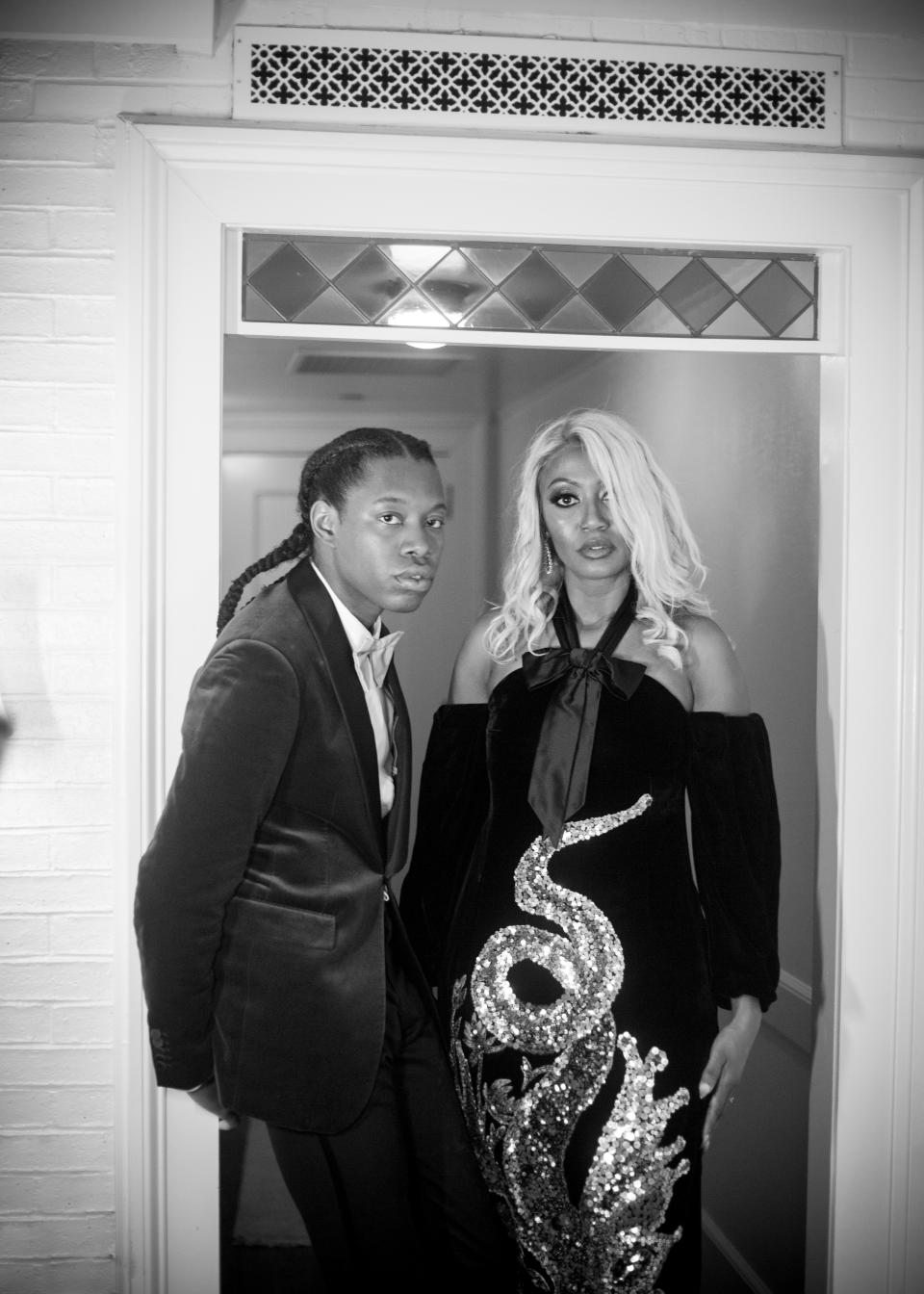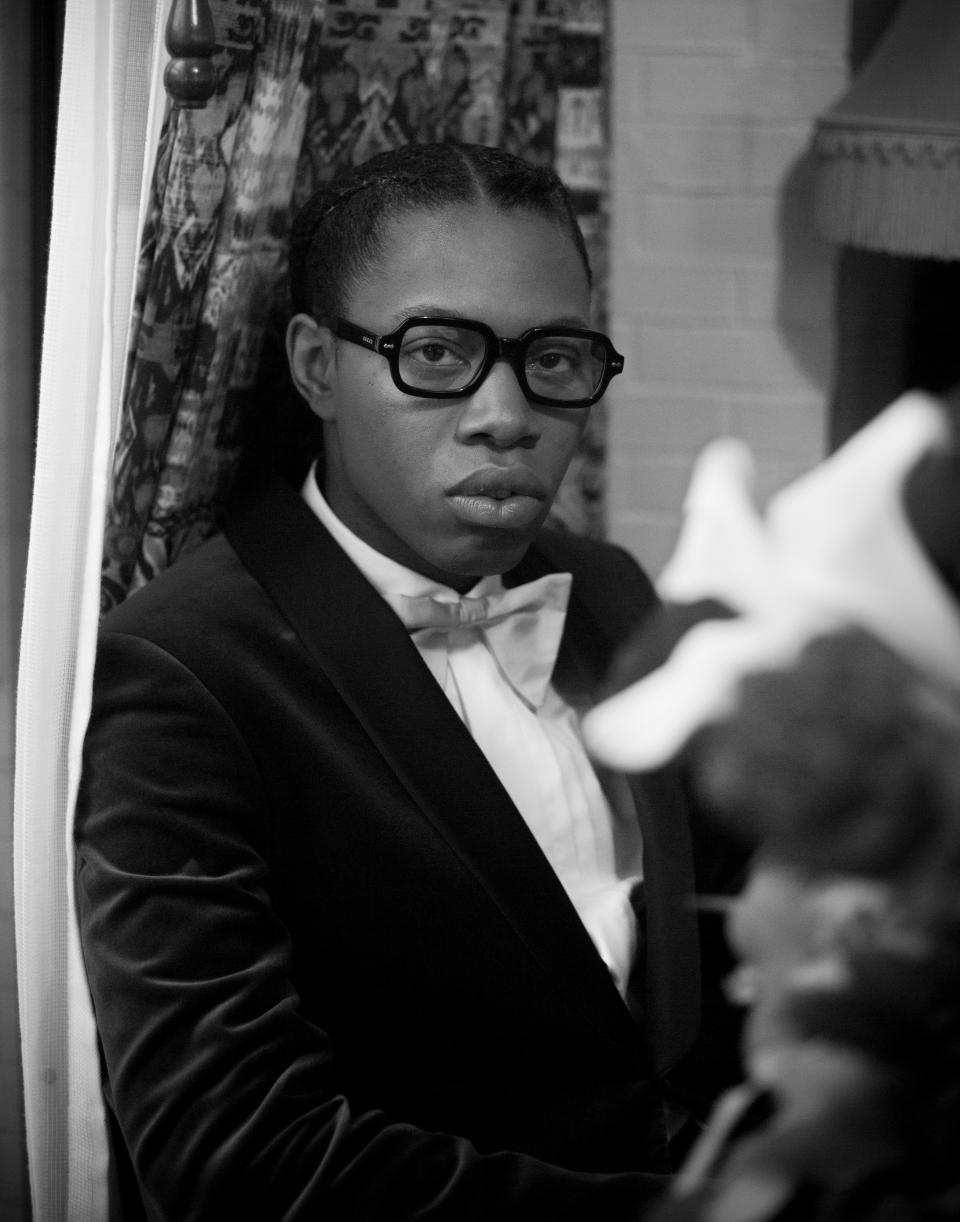"Slave Play" Writer Jeremy O. Harris On Exploring Race Through Art
Playwright Jeremy O. Harris feels a little bit under the weather. Fresh from a hot shower, pacing a suite at the Bowery Hotel in his fluffy white bathrobe, the 30-year-old creator of Broadway’s Slave Play takes his sniffles in stride. “There’s this thing about having a bad dress rehearsal meaning you’re going to have a good run,” he says, dabbing his nose with a towel. “Maybe being sick for your opening means something good as well.”
In just a few hours, actresses Zazie Beetz and Maggie Gyllenhaal, painter Kehinde Wiley, music producer Mark Ronson and more will walk the red carpet outside the Golden Theatre for the star-studded opening night debut of Slave Play. Written in 2017 while Jeremy studied at the Yale School of Drama, the controversial play makes him the youngest Black male playwright in Broadway history. Teen Vogue catches him in the middle of a recurring ritual, sharing the moment with his hairstylist mom Veronica Farrish, a makeup artist, a proud distant relative or two, and an assistant steaming his Gucci fit for the night.
“Opening nights, I always get a hotel room,” Jeremy says. “I give my phone away. And I don’t read reviews until the next morning when they get brought up.”
Those reviews have been overwhelmingly positive ever since Slave Play’s initial run at the New York Theatre Workshop late last year. Bringing touchy, uncomfortable truths to light about interracial relationships, sexuality and racial trauma — using a backdrop that invokes slavery and plantation life — the wild success of the play was hardly guaranteed. Especially from the pen of a queer African-American millennial. Overpriced Broadway isn’t called “the Great White Way” for nothing, and so Slave Play’s tremendous popularity might seem like a paradox. But not to Jeremy.

Leaning his six-foot, five-inch frame into a chair underneath his mother’s hairdryer, he says, “That’s sort of been a constant in Black art since the earliest Black poems were published, since the earliest Black theater was being done, the earliest Black music. You watch videos of Nina Simone singing ‘Mississippi Goddam’ in front of audiences, and them completely recognizing it, but also going back to their daily lives right after they’ve supported it. I feel like that’s sort of the natural state of the Black artist. All we can do is articulate the things we need to articulate for ourselves, and for the audiences that are there with us. It’s less about what they’re gonna do with it and more about the act of doing it to begin with.”
Slave Play features three mixed-race couples at a sex therapy retreat on an old Virginia plantation (Jeremy grew up in Martinsville, Virginia), analyzing their problems together with a fourth mixed-race couple of female Yale therapists (Jeremy studied playwriting at Yale). Comical, dramatic, and wincingly excruciating at times, the play covers territory Broadway has never explored before. When one psychoanalyst micro-aggressively interrupts her girlfriend’s explanation about microaggressions, it’s funny but also instructive in a “show, don’t tell” way. When white characters talk too much in a space that’s supposed to be about the healing breakthroughs of their partners, that too makes plain what the Black characters are complaining about all along.
Amazingly enough, Jeremy had never even seen his first Broadway play until three years ago. As the opening hour draws near and the nervous energy rises, a cousin pops the cork on a congratulatory bottle of Veuve Clicquot and talk turns to influences. The masterfully written scenes and witty dialogue of Slave Play can’t have come from thin air, and Jeremy speaks fluidly about his inspirations.
“Suzan-Lori Parks,” the Pulitzer Prize-winning playwright most famous for Topdog/Underdog, “was a huge influence on me. One of the first plays of hers I read was called In the Blood. I read it when I was 15 and was like, ‘This is the coolest play ever!’ I saw everything about the way she crafted a play. All of that became how I understood theater.” Bringing up the late, great August Wilson (Fences) is as obvious as mentioning Shakespeare. “I feel like August Wilson is so ubiquitous that he felt mainstream,” he says. “I avoided him when I would talk about the things that inspired me because I felt like it was obvious that he inspired everyone, or at least opened doors for everyone.”
Dustin Wills walks in, director of Jeremy’s next play, 2020’s upcoming A Boy’s Company Presents: “Tell Me If I’m Hurting You.” After a brief chat about a flight to London the next day (England auditions for yet another play, Daddy), Jeremy continues his train of thought about other major African-American playwrights. “I don’t think that I run to James Baldwin as a playwright the same way that I run to other playwrights,” he admits. “I think what I like is that he was an artist and a writer who could not be contained to a medium, which I think is rare. I aspire to that myself, so I really love seeing that sort of freedom in his work.”
Kenny Leon, the most commercially successful Black playwright of the 2000s, “came to Yale the year after I left, so I’ve never met him,” Jeremy says. (Hours later, Kenny enjoyed Slave Play and hung out at the opening night party.) “But what I can say about his work from afar is that I think he’s less interested in avant-garde art than I am. For me, if I’m gonna see a revival of a play, I’ll probably not go see a Lorraine Hansberry revival [like the Kenny Leon-directed A Raisin in the Sun] as quickly as I’ll go see a Columbia University revival of an Adrienne Kennedy play.”

Provocateurs who push buttons with their work have to expect criticism along with praise, and as a caravan of cars starts to arrive downstairs, conversation shifts to Slave Play’s harshest critics.
When previews began in September, playwright Liza Jessie Peterson (The Peculiar Patriot) sounded off on social media. If you couldn’t stomach Jeremy’s play, then Liza’s reasoning is probably why, and so I read him her post. Slave Play doesn’t work for everybody. Some feel like it uses Black trauma for entertainment value and playing the horrors of enslavement for laughs inflicts painful injury. (Slave Play’s ending borders on rape role-play; another scene shows a straight Black male character getting humped with a dildo.) For them, Jeremy O. Harris dwells down in the proverbial Sunken Place coined in Get Out; Slave Play’s artistic payoffs can’t justify violence against Black bodies; and he’s exactly the kind of “self-loathing” Black artist the mainstream loves to elevate.
I hesitated to go there in front of his family, but Jeremy welcomed the critique, apparently because he’s long been used to it. (“Did she write this under [playwright] Keith Josef Adkins’s post?” he asks, already familiar with it.) As a cousin sneaks a sip from his champagne flute, he snuffles and responds from the heart.
“I never would have written this play if it was from a space to injure anyone. I’m not an injuring type,” he says. “But I’m also not in the business of pretending that abjection is not a space that Black bodies navigate a lot. To be Black in this country is to be in an abject positionality constantly. There are people who would rather have Black representational art exist as a form of fabulation. That’s fine for them. But I’m interested in my reality. A big part of my reality is that I walk through the world injured a lot. If me articulating my own injury makes someone else feel like I was injuring them, then all I can do is apologize.”
With less than an hour before curtain, his mother works his braids double-time while he continues his defense. “None of the art I actually like is widely embraced by everyone,” he says. “There are so many white people who did not like this play who actually didn’t want this play to go to Broadway, which is why it didn’t last December when it was supposed to. If white people were obsessed with this play, Slave Play would’ve been nominated for a Tony in 2019.
“So many Black people I’ve talked to told me that this work felt healing for them, to see their traumas — that they’ve not been able to articulate — articulated on stage,” he concludes. “It’s felt healing to see people have to sit in recognition of the microaggressions that they enact every day. This moment of recognition has made them feel like someone stood on the front lines and articulated something that they wanted to and didn’t have the words for.”
Originally Appeared on Teen Vogue

